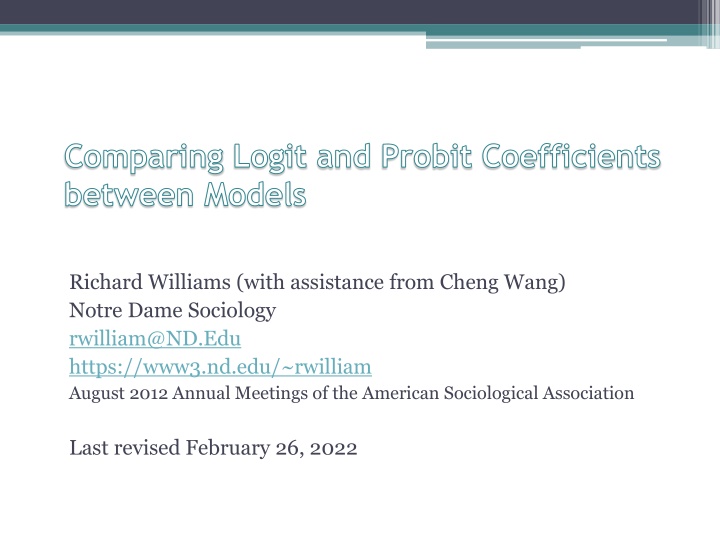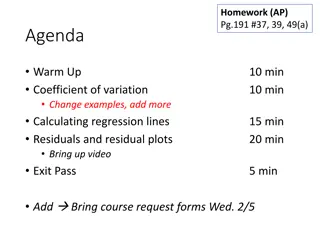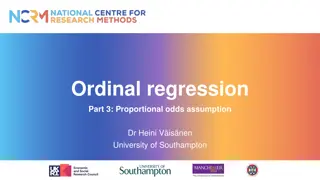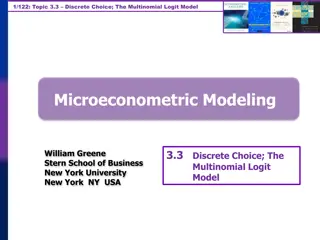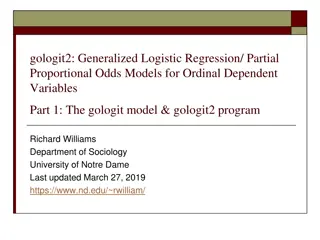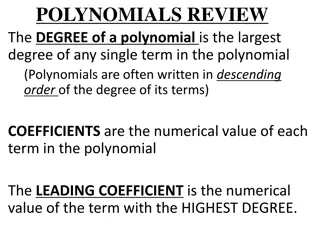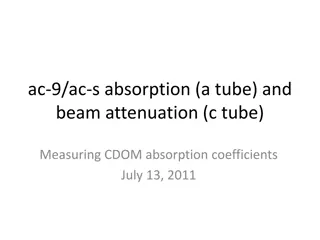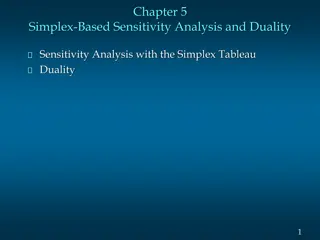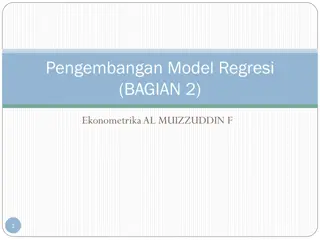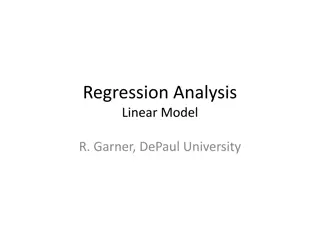Comparing Logit and Probit Coefficients between Models
Richard Williams, with assistance from Cheng Wang, discusses the comparison of logit and probit coefficients in regression models. The essence of estimating models with continuous independent variables is explored, emphasizing the impact of adding explanatory variables on explained and residual variances. The analysis delves into OLS regression, highlighting how the variance of the observed variable remains constant. The content also touches on nested regression models and scenarios where the observed variable is a collapsed version of an unobserved variable, offering examples such as approval ratings and income categories.
Download Presentation

Please find below an Image/Link to download the presentation.
The content on the website is provided AS IS for your information and personal use only. It may not be sold, licensed, or shared on other websites without obtaining consent from the author.If you encounter any issues during the download, it is possible that the publisher has removed the file from their server.
You are allowed to download the files provided on this website for personal or commercial use, subject to the condition that they are used lawfully. All files are the property of their respective owners.
The content on the website is provided AS IS for your information and personal use only. It may not be sold, licensed, or shared on other websites without obtaining consent from the author.
E N D
Presentation Transcript
Comparing Logit and Probit Coefficients between Models Richard Williams (with assistance from Cheng Wang) Notre Dame Sociology rwilliam@ND.Edu https://www3.nd.edu/~rwilliam August 2012 Annual Meetings of the American Sociological Association Last revised February 26, 2022
Introduction We are used to estimating models where an observed, continuous independent variable, Y, is regressed on one or more independent variables, i.e. = + + 2 , (0, ) Y X N Since the residuals are uncorrelated with the Xs, it follows that = = + + ( ) ( ) ( ) V Y V X V Explained Variance + Residual Variance
As you add explanatory variables to a model, the variance of the observed variable Y stays the same in OLS regression. As the explained variance goes up, the residual variance goes down by a corresponding amount. Put another way As the next slide shows, as you add variables to an OLS regression, the Total Sum of Squares stays the same, but the allocation between the Model (Explained) and Residual (Unexplained) Sums of Squares shifts, i.e. adding more variables increases the Explained SS and decreases the unexplained SS by a corresponding amount. Recall too that MS Total is the variance of y. It stays the same regardless of what variables are added or dropped from the model. In this case it equals 1.4549. In other words, v(y) is a fixed quantity and does not depend on the variables in the model.
. nestreg: reg health black (age sex height weight) Block 1: black Source | SS df MS Number of obs = 10,335 -------------+---------------------------------- F(1, 10333) = 173.65 Model | 248.486541 1 248.486541 Prob > F = 0.0000 Residual | 14786.5348 10,333 1.43100115 R-squared = 0.0165 -------------+---------------------------------- Adj R-squared = 0.0164 Total | 15035.0214 10,334 1.4549082 Root MSE = 1.1962 [Output deleted] Block 2: age sex height weight Source | SS df MS Number of obs = 10,335 -------------+---------------------------------- F(5, 10329) = 410.86 Model | 2494.19977 5 498.839954 Prob > F = 0.0000 Residual | 12540.8216 10,329 1.21413705 R-squared = 0.1659 -------------+---------------------------------- Adj R-squared = 0.1655 Total | 15035.0214 10,334 1.4549082 Root MSE = 1.1019
But suppose the observed Y is not continuous instead, it is a collapsed version of an underlying unobserved variable, Y* Examples: Do you approve or disapprove of the President's health care plan? 1 = Approve, 2 = Disapprove Income, coded in categories like $0 = 1, $1- $10,000 = 2, $10,001-$30,000 = 3, $30,001-$60,000 = 4, $60,001 or higher = 5
For such variables, also known as limited dependent variables, we know the interval that the underlying Y* falls in, but not its exact value Binary & Ordinal regression techniques allow us to estimate the effects of the Xs on the underlying Y*. They can also be used to see how the Xs affect the probability of being in one category of the observed Y as opposed to another.
The latent variable model in binary logistic regression can be written as * , Standard Logistic y X = + + If y* >= 0, y = 1 If y* < 0, y = 0 In logistic regression, the errors are assumed to have a standard logistic distribution. A standard logistic distribution has a mean of 0 and a variance of 2/3, or about 3.29.
Since the residuals are uncorrelated with the Xs, it follows that = + + = + + = + ) 3.29 + 2 ( *) V y ( ) ( ) ( ) /3 ( V x V V x V x * y Notice an important difference between OLS and Logistic Regression. In OLS regression with an observed variable Y, V(Y) is fixed and the explained and unexplained variances change as variables are added to the model. But in logistic regression with an unobserved variable y*, V( y*) is fixed so the explained variance and total variance change as you add variables to the model. This difference has important implications. Comparisons of coefficients between nested models and across groups do not work the same way in logistic regression as they do in OLS.
Comparing Logit and Probit Coefficients across Models . use https://www3.nd.edu/~rwilliam/statafiles/standardized.dta, clear . logit ybinary x1, nolog Logistic regression Number of obs = 500 LR chi2(1) = 161.77 Prob > chi2 = 0.0000 Log likelihood = -265.54468 Pseudo R2 = 0.2335 ybinary Coef. Std. Err. z P>|z| [95% Conf. Interval] x1 .7388677 .0729611 10.13 0.000 .5958667 .8818688 _cons -.0529777 .105911 -0.50 0.617 -.2605594 .154604 . logit ybinary x2, nolog Logistic regression Number of obs = 500 LR chi2(1) = 160.35 Prob > chi2 = 0.0000 Log likelihood = -266.25298 Pseudo R2 = 0.2314 ybinary Coef. Std. Err. z P>|z| [95% Conf. Interval] x2 .4886751 .0482208 10.13 0.000 .394164 .5831861 _cons -.0723833 .1058261 -0.68 0.494 -.2797987 .1350321
. logit ybinary x1 x2, nolog Logit estimates Number of obs = 500 LR chi2(2) = 443.39 Prob > chi2 = 0.0000 Log likelihood = -124.73508 Pseudo R2 = 0.6399 ------------------------------------------------------------------------------ ybinary | Coef. Std. Err. z P>|z| [95% Conf. Interval] -------------+---------------------------------------------------------------- x1 | 1.78923 .1823005 9.81 0.000 1.431927 2.146532 x2 | 1.173144 .1207712 9.71 0.000 .9364369 1.409851 _cons | -.2144856 .1626906 -1.32 0.187 -.5333532 .1043821 ------------------------------------------------------------------------------ Usually, when we add variables to a model (at least in OLS regression), the effects of variables added earlier goes down. However, in this case, we see that the coefficients for x1 and x2 increase (seemingly) dramatically when both variables are in the model, i.e. in the separate bivariate regressions the effects of x1 and x2 are .7388678 and .4886751, but in the multivariate regressions the effects are 1.78923 and 1.173144, more than twice as large as before. This leads to two questions: 1. If we saw something similar in an OLS regression, what would we suspect was going on? In other words, in an OLS regression, what can cause coefficients to get bigger rather than smaller as more variables are added? 2. In a logistic regression, why might such an interpretation be totally wrong?
. corr, means (obs=500) Variable | Mean Std. Dev. Min Max -------------+---------------------------------------------------- y | 5.51e-07 3.000001 -8.508021 7.981196 ybinary | .488 .5003566 0 1 x1 | -2.19e-08 2 -6.32646 6.401608 x2 | 3.57e-08 3 -10.56658 9.646875 | y ybinary x1 x2 -------------+------------------------------------ y | 1.0000 ybinary | 0.7923 1.0000 x1 | 0.6667 0.5248 1.0000 x2 | 0.6667 0.5225 0.0000 1.0000 x1 and x2 are uncorrelated! So suppressor effects cannot account for the changes in coefficients. Long & Freese s listcoef command can add some insights.
. quietly logit ybinary x1 . listcoef, std logit (N=500): Unstandardized and Standardized Estimates Observed SD: .50035659 Latent SD: 2.3395663 Odds of: 1 vs 0 ------------------------------------------------------------------------------- ybinary | b z P>|z| bStdX bStdY bStdXY SDofX -------------+----------------------------------------------------------------- x1 | 0.73887 10.127 0.000 1.4777 0.3158 0.6316 2.0000 ------------------------------------------------------------------------------- . quietly logit ybinary x2 . listcoef, std logit (N=500): Unstandardized and Standardized Estimates Observed SD: .50035659 Latent SD: 2.3321875 Odds of: 1 vs 0 ------------------------------------------------------------------------------- ybinary | b z P>|z| bStdX bStdY bStdXY SDofX -------------+----------------------------------------------------------------- x2 | 0.48868 10.134 0.000 1.4660 0.2095 0.6286 3.0000 -------------------------------------------------------------------------------
. quietly logit ybinary x1 x2 . listcoef, std logit (N=500): Unstandardized and Standardized Estimates Observed SD: .50035659 Latent SD: 5.3368197 Odds of: 1 vs 0 ------------------------------------------------------------------------------- ybinary | b z P>|z| bStdX bStdY bStdXY SDofX -------------+----------------------------------------------------------------- x1 | 1.78923 9.815 0.000 3.5785 0.3353 0.6705 2.0000 x2 | 1.17314 9.714 0.000 3.5194 0.2198 0.6595 3.0000 -------------------------------------------------------------------------------
Note how the standard deviation of y* fluctuates from one logistic regression to the next; it is about 2.34 in each of the bivariate logistic regressions and 5.34 in the multivariate logistic regression. It is because the variance of y* changes that the coefficients change so much when you go from one model to the next. In effect, the scaling of Y* is different in each model. By way of analogy, if in one OLS regression income was measured in dollars, and in another it was measured in thousands of dollars, the coefficients would be very different.
Why does the variance of y* go up? Because it has to. The residual variance is fixed at 3.29, so improvements in model fit result in increases in explained variance which in turn result in increases in total variance. Hence, comparisons of coefficients across nested models can be misleading because the dependent variable is scaled differently in each model.
How serious is the problem in practice? Hard to say. We easily found dozens of recent papers that present sequences of nested models. Their numbers are at least a little off, but without re- analyzing the data you can t tell whether their conclusions are seriously distorted as a result. Several attempts of our own using real world data have failed to raise major concerns with the comparisons We asked several authors for copies of their data, but most were unwilling or unable to do so.
One author, Ervin (Maliq) Matthew, did graciously provide us with the data used for his paper Effort Optimism in the Classroom: Attitudes of Black and White Students on Education, Social Structure, and Causes of Life Opportunities (Sociology of Education 2011 84:225-245) The paper contains potentially problematic statements such as The effect of race on the dependent variable is even stronger once GPA, SES, and sex are controlled for (Model 2), indicating that when blacks and whites have equal GPAs and family SES, blacks are more likely to agree with this statement. In practice, however, we found that any potential errors were modest. For example, his Table 7 somewhat understates how much the effect of race declines as controls are added. (We semi-replicate his work later in this handout.)
Nonetheless, researchers should realize that Increases in the magnitudes of coefficients across models need not reflect suppressor effects Declines in coefficients across models will actually be understated, i.e. you will be understating how much other variables account for the estimated direct effects of the variables in the early models. Distortions are potentially more severe when added variables greatly increase the pseudo R^2 statistics, as the variance of Y* will increase more when that is the case.
What are possible solutions? Just don t present the coefficients for each model in the first place. Researchers often present chi-square contrasts to show how they picked their final model and then only present the coefficients for it. Use y-standardization. With y-standardization, instead of fixing the residual variance, you fix the variance of y* at 1. This does not work perfectly, but it does greatly reduce rescaling of coefficients between models. Listcoef gives the y-standardized coefficients in the column labeled bStdy, and they hardly changed at all between the bivariate and multivariate models (.3158 and .2095 in the bivariate models, .3353 and .2198 in the multivariate model).
The Karlson/Holm/Breen (KHB) method (Papers are available in Sociological Methodology and The Stata Journal) shows great promise According to KHB, their method separates changes in coefficients due to rescaling from true changes in coefficients that result from adding more variables to the model (and does a better job of doing so than y-standardization and other alternatives) They further claim that with their method the total effect of a variable can be decomposed into its direct effect and its indirect effect.
We would add that, when authors estimate sequences of models, it is often because they want to see how the effects of variables like race decline (or increase) after other variables are controlled for. For example, a researcher might want to know how much of the effect of race is direct and how much is indirect (e.g. race affects education and education in turn affects the dependent variable.) If some of the effect of race is indirect, then the coefficient for race should decline as more variables are added to the model. The KHB method provides a parsimonious and more accurate way of depicting such changes. We ll now present a few examples using khb, starting with the hypothetical example we had earlier.
khb Example 1: Hypothetical Data . use https://www3.nd.edu/~rwilliam/statafiles/standardized, clear . nestreg: logit ybinary x1 x2, nolog Logistic regression Number of obs = 500 LR chi2(1) = 161.77 Prob > chi2 = 0.0000 Log likelihood = -265.54468 Pseudo R2 = 0.2335 ------------------------------------------------------------------------------ ybinary | Coefficient Std. err. z P>|z| [95% conf. interval] -------------+---------------------------------------------------------------- x1 | .7388677 .0729611 10.13 0.000 .5958667 .8818688 _cons | -.0529777 .105911 -0.50 0.617 -.2605594 .154604 ------------------------------------------------------------------------------ Logistic regression Number of obs = 500 LR chi2(2) = 443.39 Prob > chi2 = 0.0000 Log likelihood = -124.73508 Pseudo R2 = 0.6399 ------------------------------------------------------------------------------ ybinary | Coefficient Std. err. z P>|z| [95% conf. interval] -------------+---------------------------------------------------------------- x1 | 1.78923 .1823053 9.81 0.000 1.431918 2.146541 x2 | 1.173144 .1207745 9.71 0.000 .9364304 1.409858 _cons | -.2144855 .1626923 -1.32 0.187 -.5333566 .1043856 ------------------------------------------------------------------------------
. khb logit ybinary x1 || x2 Decomposition using the KHB-Method Model-Type: logit Number of obs = 500 Variables of Interest: x1 Pseudo R2 = 0.64 Z-variable(s): x2 ------------------------------------------------------------------------------ ybinary | Coefficient Std. err. z P>|z| [95% conf. interval] -------------+---------------------------------------------------------------- x1 | Reduced | 1.78923 .1823053 9.81 0.000 1.431918 2.146541 Full | 1.78923 .1823053 9.81 0.000 1.431918 2.146541 Diff | 1.05e-08 .0011743 0.00 1.000 -.0023016 .0023016 ------------------------------------------------------------------------------
As was the case when we ran this example before, the logistic regressions made it appear that the estimated effect of x1 more than doubled when x2 was added. khb shows that, in reality, the effect of x1 doesn t change at all. The change shown earlier was entirely due to the rescaling of Y*.
Khb Example 2: Matthew Replication Matthew (2011; see Table 7, p. 240) examines the determinants of how likely a student is to feel they will have a job he or she enjoys (0 = 50 percent or lower; 1 = better than 50 percent). For unclear reasons, our replication results differ slightly from those presented in the paper. In the first model (see next slide), race (0 = white, 1 = black) is the only independent variable. The estimated effect of race is - .507. In the final model controls are added for GPA, SES, and others. The effect of race declines to -.483, an apparent -.024 drop.
. use https://www3.nd.edu/~rwilliam/statafiles/soe2011, clear . nestreg: logit jobenjoy i.race (gpa ses sex educjob educimportant luckimportant sbprevent Logistic regression Number of obs = 6,731 LR chi2(1) = 22.74 Prob > chi2 = 0.0000 Log likelihood = -2740.9172 Pseudo R2 = 0.0041 ------------------------------------------------------------------------------ jobenjoy | Coefficient Std. err. z P>|z| [95% conf. interval] -------------+---------------------------------------------------------------- race | Black | -.5071732 .1023392 -4.96 0.000 -.7077544 -.306592 _cons | 1.856833 .0375953 49.39 0.000 1.783147 1.930518 ------------------------------------------------------------------------------ Logistic regression Number of obs = 6,731 LR chi2(8) = 423.84 Prob > chi2 = 0.0000 Log likelihood = -2540.3718 Pseudo R2 = 0.0770 ------------------------------------------------------------------------------- jobenjoy | Coefficient Std. err. z P>|z| [95% conf. interval] --------------+---------------------------------------------------------------- race | Black | -.4833004 .1095584 -4.41 0.000 -.6980309 -.26857 gpa | .2896685 .0548232 5.28 0.000 .1822171 .39712 ses | .0984206 .0527711 1.87 0.062 -.0050088 .20185 sex | .1113716 .073942 1.51 0.132 -.0335521 .2562953 educjob | .2508703 .1794196 1.40 0.162 -.1007857 .6025263 educimportant | .9474587 .0860938 11.00 0.000 .778718 1.116199 luckimportant | -.2183139 .1183016 -1.85 0.065 -.4501808 .0135529 sbprevent | -.8611827 .079129 -10.88 0.000 -1.016273 -.7060928 _cons | .1883665 .233478 0.81 0.420 -.269242 .645975 -------------------------------------------------------------------------------
The khb method (shown in the next slide) shows that the decline is actually about four times as great, -.089. Again this is at least partly because the variance of y* becomes greater as more variables are added, causing coefficients to increase. Put another way, the effect of race in model 1, .507, is adjusted upwards to -.5772, to reflect the increased variance of Y* as more variables are added. Putting it yet another way, the indirect effect of race is underestimated if we don t make the khb correction. It appears that the indirect effect of race is only .024 when it is really .089. Without the KHB correction, you would underestimate the importance of the indirect effects race has by influencing other variables which in turn affect whether or not a person enjoys their job.
. khb logit jobenjoy race || gpa ses sex educjob educimportant luckimportant sbprevent Decomposition using the KHB-Method Model-Type: logit Number of obs = 6731 Variables of Interest: race Pseudo R2 = 0.08 Z-variable(s): gpa ses sex educjob educimportant luckimportant sbprevent ------------------------------------------------------------------------------ jobenjoy | Coefficient Std. err. z P>|z| [95% conf. interval] -------------+---------------------------------------------------------------- race | Reduced | -.5727334 .10607 -5.40 0.000 -.7806269 -.3648399 Full | -.4833004 .1095584 -4.41 0.000 -.6980309 -.26857 Diff | -.089433 .0349898 -2.56 0.011 -.1580117 -.0208542 ------------------------------------------------------------------------------
Marginal Effects Both Mize, Doan, & Long (2019) and Karlson, Holm, & Breen (2012) argue that it may be better to look at changes in marginal effects across nested models, rather than changes in coefficients. KHB note that marginal effects have more intuitive appeal than do coefficients. MDL further note that rescaling is not an issue with marginal effects The KHB and MDL methods differ though
The Mize/Doan/Long Approach: Report average marginal effects of variables In Example 1, . use http://www3.nd.edu/~rwilliam/statafiles/standardized.dta, clear . qui logit ybinary x1, nolog . qui margins, dydx(*) post . est store m1 . qui logit ybinary x2, nolog . qui margins, dydx(*) post . est store m2 . qui logit ybinary x1 x2, nolog . qui margins, dydx(*) post . est store m3 . esttab m1 m2 m3, z ------------------------------------------------------------ (1) (2) (3) ------------------------------------------------------------ x1 0.132*** 0.139*** (18.74) (31.75) x2 0.0874*** 0.0909*** (18.77) (27.49) ------------------------------------------------------------ N 500 500 500 ------------------------------------------------------------ z statistics in parentheses
The marginal effects changed far less than the coefficients did (although it may seem odd that they changed at all, given that x1 and x2 are uncorrelated). Mize, Doan, & Long (2019) demonstrate how to do formal tests of whether marginal effects significantly differ across nested models. (In this case, they don t.) See example 6.2 in https://journals.sagepub.com/doi/full/10.1177/0081175019852763 The coding is a little complicated (Mize is working on do files to simplify it) but the code and data used in Mize s paper is (as of February 26, 2022) at https://drive.google.com/drive/folders/18RS5C47b_ddGaRRXILfmxmfOB 41AyA7D
The MDL approach includes output like the following. The main thing it adds to the margins commands just shown is a formal test of whether the change in marginal effects is statistically significant. Average Discrete Changes for x1 and cross-model differences | lincom se pvalue ---------------------+------------------------------ ADC x1 | Model 1 | 0.132 0.007 0.000 Model 2 | 0.139 0.004 0.000 ---------------------+------------------------------ Diff in ADCs | M1 - M2 | -0.007 0.005 0.168
KHB provides what may be a better way to compare marginal effects across nested models. They argue that estimating marginal effects model by model (like MDL do and we just did in Example 1) will give at least slightly erroneous results. They show how to correct for this. Using their ape (Average Partial Effect) option, even the small differences in marginal effects we saw in Example 1 across nested models go away.
. khb logit ybinary x1 || x2, ape Decomposition using the APE-Method Model-Type: logit Number of obs = 500 Variables of Interest: x1 Pseudo R2 = 0.64 Z-variable(s): x2 ------------------------------------------------------------------------------ ybinary | Coefficient Std. err. z P>|z| [95% conf. interval] -------------+---------------------------------------------------------------- x1 | Reduced | .1386605 .0043668 31.75 0.000 .1301018 .1472192 Full | .1386605 .0043668 31.75 0.000 .1301018 .1472192 Diff | 3.42e-10 . . . . . ------------------------------------------------------------------------------ Note: Standard errors of difference not known for APE method
Applying the MDL method to Example 2, Average Discrete Changes for i.race and cross-model differences | lincom se pvalue ---------------------+------------------------------ ADC i.race | Model 1 | -0.071 0.016 0.000 Model 2 | -0.061 0.016 0.000 ---------------------+------------------------------ Diff in ADCs | M1 - M2 | -0.010 0.006 0.103
Applying khb with the ape option to Example 2, . khb logit jobenjoy i.race || gpa ses sex educjob educimportant luckimportant s > bprevent, ape Decomposition using the APE-Method Model-Type: logit Number of obs = 6731 Variables of Interest: i.race Pseudo R2 = 0.08 Z-variable(s): gpa ses sex educjob educimportant luckimportant sbprevent ------------------------------------------------------------------------------ jobenjoy | Coefficient Std. err. z P>|z| [95% conf. interval] -------------+---------------------------------------------------------------- 0.race | (base outcome) -------------+---------------------------------------------------------------- 1.race | Reduced | -.0742168 .0154848 -4.79 0.000 -.1045665 -.043867 Full | -.0613298 .0154254 -3.98 0.000 -.0915631 -.0310966 Diff | -.0128869 . . . . . ------------------------------------------------------------------------------ Note: Standard errors of difference not known for APE method
For Example 2 Estimating marginal effectss the MDL way, the marginal effect of race declines by about .010 between nested models. The change is NOT statistically significant at even the .10 level. However, using khb, the change is slightly larger, about .013. Unfortunately, khb does NOT provide a test of the statistical significance of the change. It may not matter that much whether or not you just estimate the marginal effects model by model like MDL do or if you use khb, as the differences seem to be minor in practice. (I ve asked Mize & Long what they think.)
Summary When you estimate a series of nested models using logit or probit, comparisons of coefficients across models may be problematic, because Y* is scaled differently in each model. You may just want to not even present the results from nested models. Often people do so but ignore everything but the final model. So why waste space on something you aren t using and which could mislead people?
If you do want to present sequences of nested models and see how coefficients change (e.g. you want to see how the effect of race declines as more variables are added to the model) you probably want to use the khb method so results across models are directly comparable. Rather than focusing on how coefficients change, you may prefer to focus on how marginal effects change. This may be more intuitively meaningful. Mize, Doan, & Long (2019), as well as Karlson, Holm, and Breen (2012), have suggested ways to validly compare marginal effects across nested models. I m currently not sure which is best. According to KHB the MDL approach seems slightly off. On the other hand MDL provides a formal statistical test of the differences between marginal effects but KHB does not. The KHB software is currently much easier to use but easier-to-use software for MDL may be coming. In any event, it may not matter that much as differences between the two approaches seem to be small.
Selected References Karlson, Kristian B., Anders Holm and Richard Breen. 2011. Comparing Regression Coefficients between Same-Sample Nested Models using Logit and Probit: A New Method. https://journals.sagepub.com/doi/10.1177/0081175012444861. Sociological Methodology August 2012 vol. 42 no. 1 286-313 Abstract: Logit and probit models are widely used in empirical sociological research. However, the common practice of comparing the coefficients of a given variable across differently specified models fitted to the same sample does not warrant the same interpretation in logits and probits as in linear regression. Unlike linear models, the change in the coefficient of the variable of interest cannot be straightforwardly attributed to the inclusion of confounding variables. The reason for this is that the variance of the underlying latent variable is not identified and will differ between models. We refer to this as the problem of rescaling. We propose a solution that allows researchers to assess the influence of confounding relative to the influence of rescaling, and we develop a test to assess the statistical significance of confounding. A further problem in making comparisons is that, in most cases, the error distribution, and not just its variance, will differ across models. Monte Carlo analyses indicate that other methods that have been proposed for dealing with the rescaling problem can lead to mistaken inferences if the error distributions are very different. In contrast, in all scenarios studied, our approach performs as least as well as, and in some cases better than, others when faced with differences in the error distributions. We present an example of our method using data from the National Education Longitudinal Study
Kohler, Ulrich, Kristian B. Carlson and Anders Holm. 2011. Comparing Coefficients of nested nonlinear probability models. The Stata Journal Volume 11 Number 3: pp. 420-438. http://www.stata-journal.com/article.html?article=st0236. Abstract: In a series of recent articles, Karlson, Holm, and Breen (Breen, Karlson, and Holm, 2011, http://papers.ssrn.com/sol3/papers.cfm?abstractid=1730065; Karlson and Holm, 2011, Research in Stratification and Social Mobility 29: 221 237; Karlson, Holm, and Breen, 2010, http://www.yale.edu/ciqle/Breen Scaling%20effects.pdf) have developed a method for comparing the estimated coefficients of two nested nonlinear probability models. In this article, we describe this method and the user-written program khb, which implements the method. The KHB method is a general decomposition method that is unaffected by the rescaling or attenuation bias that arises in cross-model comparisons in nonlinear models. It recovers the degree to which a control variable, Z, mediates or explains the relationship between X and a latent outcome variable, Y , underlying the nonlinear probability model. It also decomposes effects of both discrete and continuous variables, applies to average partial effects, and provides analytically derived statistical tests. The method can be extended to other models in the generalized linear model family.
Mize, Trenton, Long Doan, & J. Scott Long. 2019. A General Framework for Comparing Predictions and Marginal Effects across Models. Sociological Methodology vol 49 no 1: pp. 152- 189. https://journals.sagepub.com/doi/full/10.1177/0081175019852763 Abstract: Many research questions involve comparing predictions or effects across multiple models. For example, it may be of interest whether an independent variable s effect changes after adding variables to a model. Or, it could be important to compare a variable s effect on different outcomes or across different types of models. When doing this, marginal effects are a useful method for quantifying effects because they are in the natural metric of the dependent variable and they avoid identification problems when comparing regression coefficients across logit and probit models. Despite advances that make it possible to compute marginal effects for almost any model, there is no general method for comparing these effects across models. In this article, the authors provide a general framework for comparing predictions and marginal effects across models using seemingly unrelated estimation to combine estimates from multiple models, which allows tests of the equality of predictions and effects across models. The authors illustrate their method to compare nested models, to compare effects on different dependent or independent variables, to compare results from different samples or groups within one sample, and to assess results from different types of models.
Matthew, Ervin (Maliq). 2011. Effort Optimism in the Classroom: Attitudes of Black and White Students on Education, Social Structure, and Causes of Life Opportunities. Sociology of Education Volume: 84 issue: 3, page(s): 225-245. https://journals.sagepub.com/doi/10.1177/0038040711402360 Abstract: Do black and white students hold similar beliefs about the causes of life opportunities? Disparities in academic performance between blacks and whites have been attributed, in part, to differing attitudes about the relationship between education and life opportunities. Advocates of oppositional culture theory argue that black students consider structural barriers to have more influence on prosperity than do their own efforts in the classroom; detractors contend that black and white students equally consider individual academic performance to be key to future life opportunities. Using the National Education Longitudinal Study, 1988 through 1992, the author demonstrates that students simultaneously accept both structural and individualistic explanations for prosperity. Black students report greater support for structural explanations than do white students, but they report equal or greater support for the relevance of education to their futures. The author finds that, while black and white students do differ in their optimism about future opportunities, dissimilar attitudes about social structure, rather than education, are accountable for this.
